Fabricated thermal resistance
Description
The assembled thermal resistance temperature sensor is matched with the display instrument to measure the temperature of liquid, gas medium and solid surface within the range of -200-600℃. It is widely used in petroleum, chemical industry, machinery, metallurgy, electric power, light textile, food, atomic energy, aerospace and other industrial sectors and scientific and technological fields. Prefabricated thermal resistors are usually composed of temperature sensing elements, mounting fixtures and junction boxes.
Optional model
Pt100, Pt1000, Cu50
Main technical specifications of assembly thermal resistance
| Thermal resistance type | Temperature range: ℃ | Degree, | Allowable deviation △t℃ | WZP type platinum resistor | - 200 ~ 420 | Pt100 | Grade B (-200~800℃) Tolerance ± (0.30+0.005/t/) |
| Grade A (-200~650℃) Tolerance ± (0.15+0.002/t/) | |||||||
| WZC type copper resistor | - 150 ~ 100 | Cu50 | - 50 ~ 100 ℃ tolerance |
Assembly thermal resistance working principle
Thermal resistance measures temperature by using the property that the resistance of a substance changes with its temperature. The heating part of the thermal resistance (temperature sensing element) is made of thin metal wire evenly double wound on the skeleton made of insulating material, when there is a temperature gradient in the measured medium, the measured temperature is the average temperature in the medium layer within the range of the temperature sensing element.
Assembly thermal resistance characteristics
| Assembly structure, good decomposition of parts, easy maintenance; |
| Low cost to replace wearing parts; |
| Complete specifications, stable and reliable performance. |
| Insulation resistance |
The normal temperature insulation resistance of platinum thermal resistance should not be less than 100M ω The normal temperature insulation resistance of copper thermal resistance should not be less than 50M ω. The test voltage of normal temperature insulation resistance is 10~100V DC. Self-heating effect: Platinum resistance allows very high current of 5mA, resulting in a temperature rise of no more than 0.3℃. Thermal response time (τ0.5) : the time required for the output of the thermal resistance to change to 50% of a step change in temperature. |
Thermal resistance time constant
| Thermal inertia level | Time constant (seconds) | Thermal inertia level | Time constant (seconds) |
| Ⅰ | 90-180. | Ⅲ | 10 to 30 |
| Ⅱ | 30-90. | Ⅳ | 10 |
| Nominal pressure of thermal resistance: generally refers to the static external pressure that the protective tube can withstand without rupture at the working temperature. |
| Thermal resistance is very small insertion depth: should not be less than 8-10 times the outer diameter of its protection sleeve. |
| Insulation resistance: when the ambient air temperature is 15-35℃, relative humidity < 80%, insulation resistance 20 megohm (voltage 100V) |
| . Insulation resistance with splashproof junction box shall be 2 megohm (voltage: 100V) |
| Resistance value (R0) of thermal resistance temperature sensing element at 0℃ and its ratio to resistance value (R100) at 100℃ : |
| Ratio = R100 / R |
| When the indexing number is Pt10 or Pt100; R100 / R0 = 1.3850 + / - 0.001 |
| When the indexing number is Cu50 and Cu100; R100 / R0 = 1.3850 + / - 0.002 |



